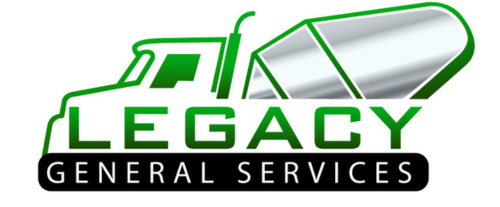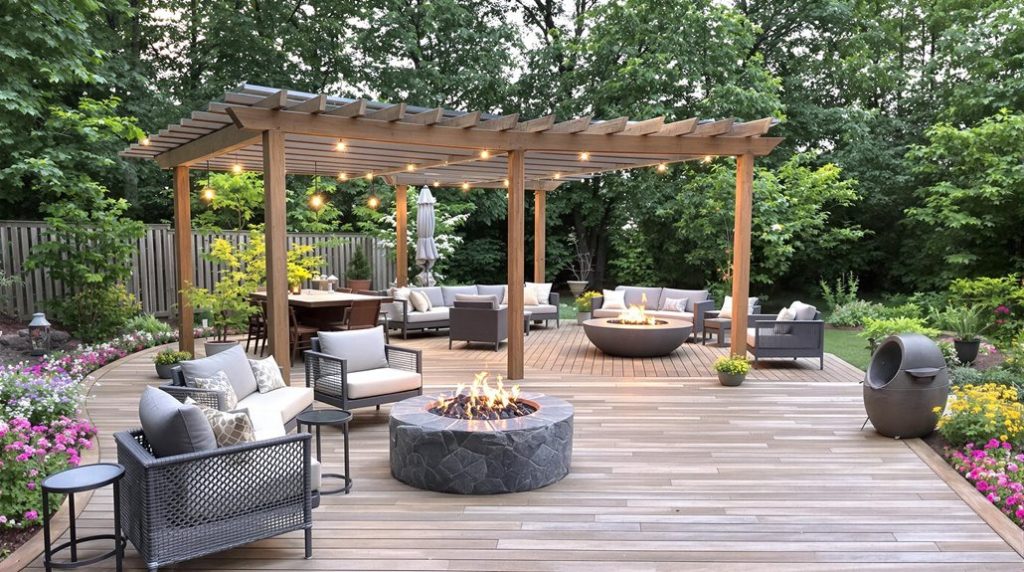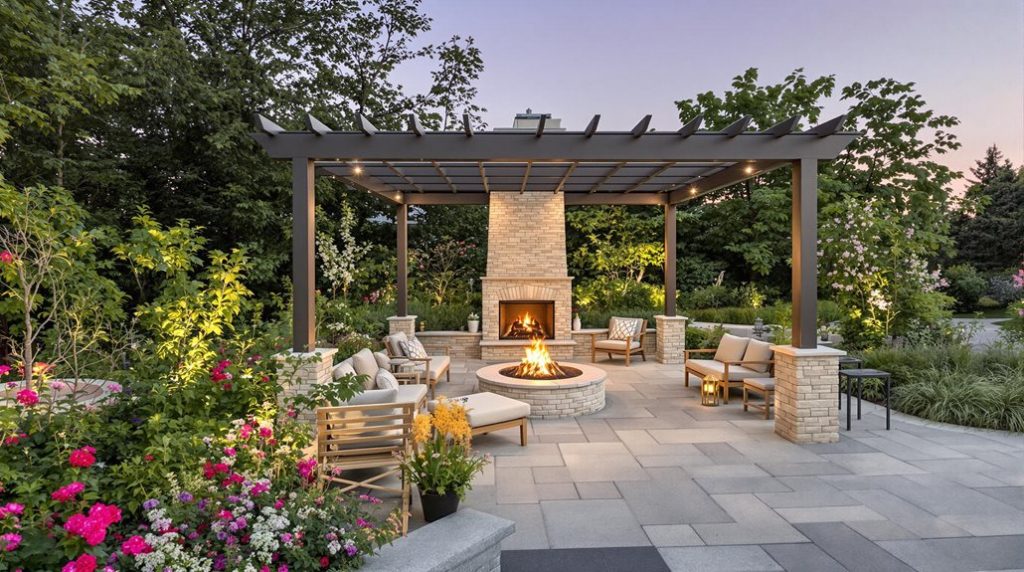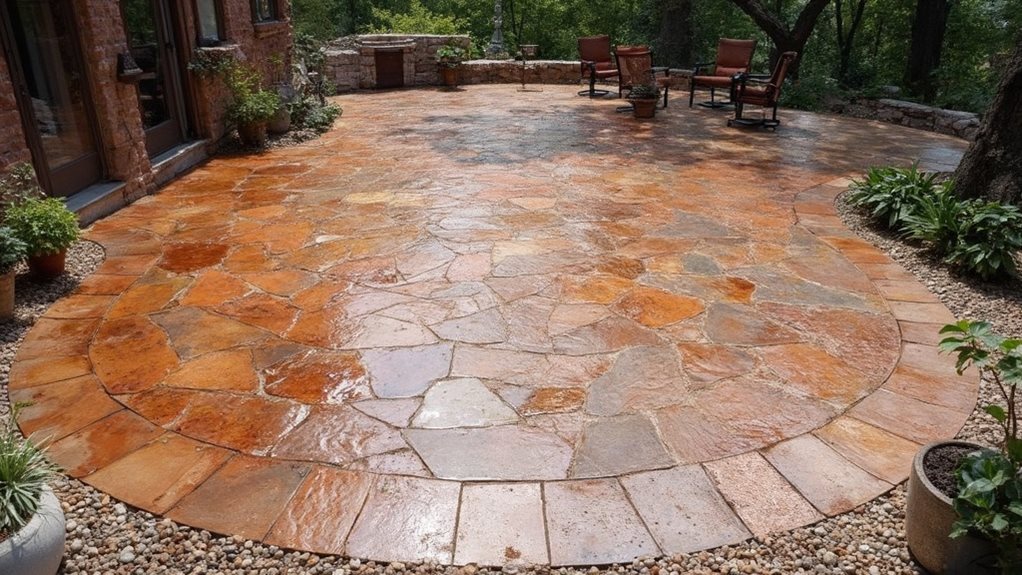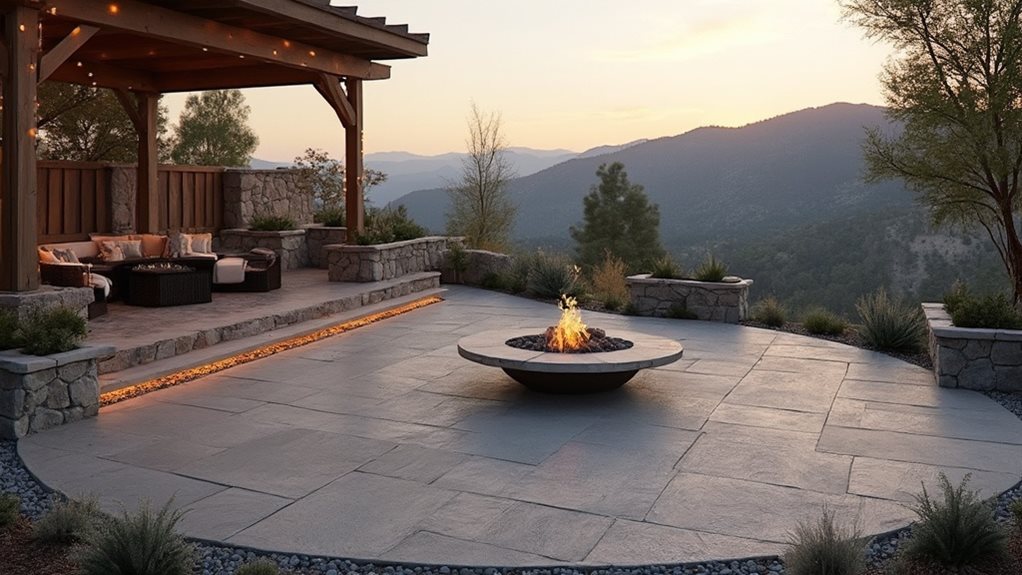Posts Tagged ‘outdoor design’
How to Build Your Dream Outdoor Living Space
Creating a dream outdoor living space requires strategic planning across multiple dimensions, beginning with a thorough site analysis for ideal layout and traffic flow. The selection of weather-resistant materials, such as marine-grade stainless steel and solution-dyed acrylic fabrics, forms the foundation for durability. Distinct functional zones, including dining areas and conversation spaces, should be established with proper spacing and clearance. Strategic lighting, climate control features, and thoughtful plant placement enhance comfort and ambiance, while proper maintenance guarantees lasting enjoyment. Further exploration reveals specific measurements and material specifications essential for success.
Expert Highlights
- Plan your layout with careful consideration of sun exposure, traffic flow, and functional zones for dining, cooking, and relaxation areas.
- Select weather-resistant materials like marine-grade stainless steel and solution-dyed acrylic fabrics for furniture and cushions.
- Install proper lighting with LED path lights and string lights for safety and ambiance in evening hours.
- Create comfortable seating arrangements using circular or U-shaped configurations with adequate spacing between furniture pieces.
- Incorporate climate control features such as retractable awnings and outdoor heating elements for year-round enjoyment.
Planning Your Perfect Outdoor Layout

Before breaking ground on any outdoor living space, careful consideration must be given to the layout's functional requirements, spatial relationships, and environmental factors that will impact its success.
The design process begins with a thorough site analysis, documenting existing conditions such as sun exposure, prevailing winds, drainage patterns, and views. These elements inform the strategic placement of key features, including seating areas, cooking stations, and shade structures.
Traffic flow analysis guarantees seamless movement between zones while maintaining appropriate spacing for safety and comfort.
Standard measurements include 36-inch walkways, 24-inch clearance between seating, and 48-inch diameter turning spaces for accessibility compliance.
Professional installation of concrete walkways can provide durability lasting up to 30 years with proper maintenance.
Selecting Weather-Resistant Materials and Furniture
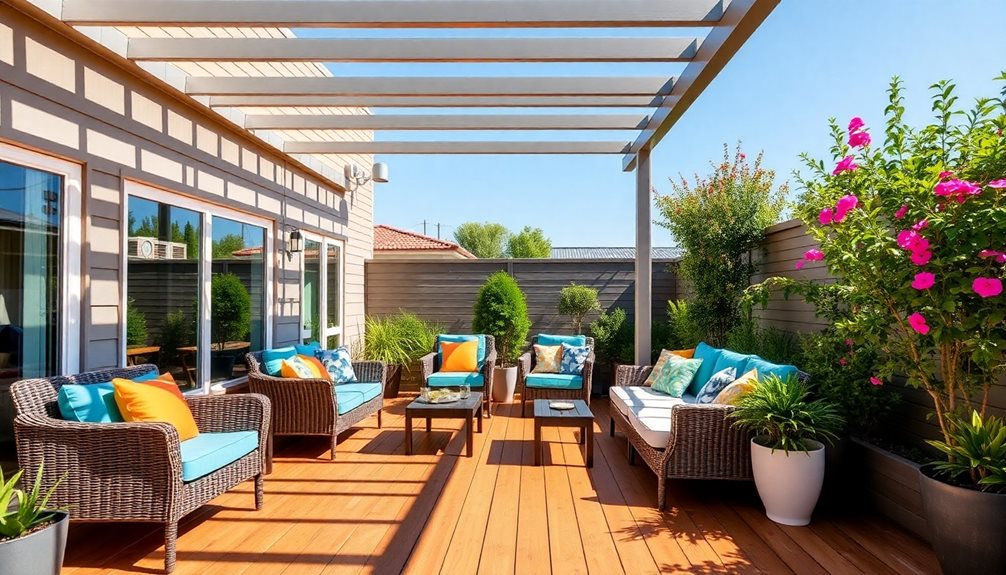
When designing an outdoor living space that will endure the elements, selecting appropriate weather-resistant materials and furnishings becomes a critical factor in ensuring long-term durability and performance.
For structural components, marine-grade stainless steel, powder-coated aluminum, and teak wood offer superior resistance to moisture, UV damage, and temperature fluctuations.
Solution-dyed acrylic fabrics, such as Sunbrella, provide fade-resistant cushions and upholstery rated for 5+ years of outdoor exposure.
High-density polyethylene (HDPE) furniture, featuring UV inhibitors and colorfast pigments, withstands extreme temperatures from -20°F to 120°F while maintaining structural integrity.
Concrete or porcelain pavers deliver slip-resistant flooring with minimal maintenance requirements.
Stamped concrete finishes offer a visually appealing and cost-effective alternative to natural stone while providing exceptional durability for outdoor spaces.
Creating Zones for Different Activities
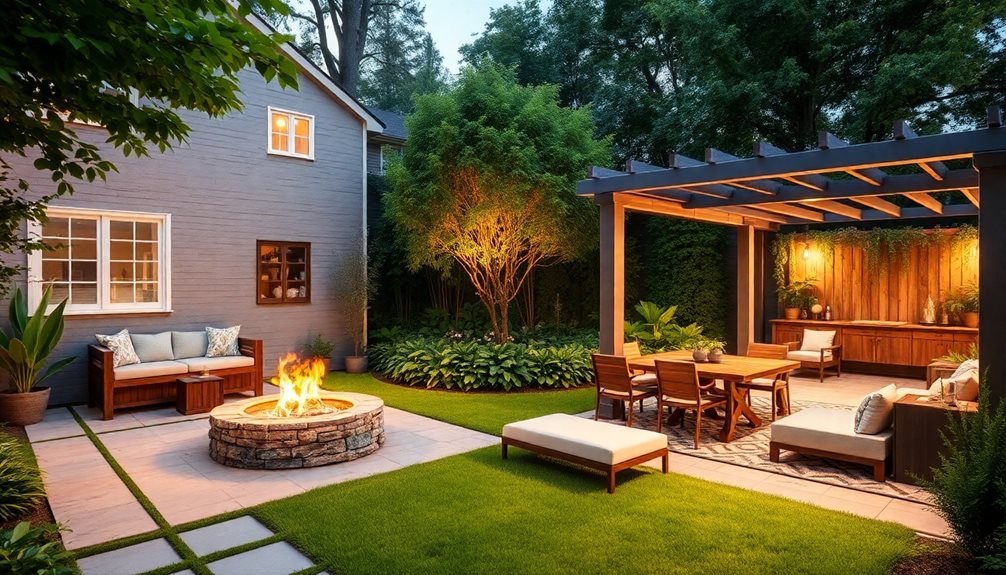
A successful outdoor living space incorporates distinct functional zones that allow for seamless changes between different activities and social gatherings. The primary zones typically include dining areas, conversation spaces, and cooking stations, strategically separated by walkways or connecting elements.
When designing these zones, spatial relationships become critical. The cooking area should maintain proximity to indoor facilities while remaining separate from relaxation spaces.
Conversation areas benefit from circular or U-shaped seating arrangements, while dining zones require adequate clearance for chair movement and service access.
Each zone should feature appropriate lighting, shade solutions, and storage elements specific to its intended function.
Similar to concrete driveway installation, proper grading and surface preparation are essential for creating stable, long-lasting outdoor living zones.
Essential Elements for Comfort and Ambiance
To create a truly inviting outdoor living space, homeowners must carefully incorporate essential comfort and ambiance elements that transform basic outdoor areas into welcoming sanctuaries.
- Strategic lighting installations, including LED path lights, adjustable overhead fixtures, and decorative string lights, establish both safety and atmosphere while extending usability into evening hours.
- Climate control features such as retractable awnings, misting systems, and outdoor heating elements guarantee year-round comfort regardless of weather conditions.
- Thoughtful acoustic elements, incorporating water features, strategic plant placement, and sound-absorbing materials, create an immersive environment while minimizing unwanted noise from surrounding areas.
A concrete patio installation provides a durable and low-maintenance foundation that requires up to 75% less upkeep than alternative outdoor flooring materials.
Expert Final Thoughts
Building an ideal outdoor living space requires careful consideration of layout, materials, zoning, and atmospheric elements. By thoughtfully selecting weather-resistant furnishings, establishing distinct functional areas, and incorporating essential comfort features like shade and lighting, homeowners can create a versatile extension of their indoor living space. With proper planning and attention to detail, an outdoor sanctuary can serve as a valuable investment in both property value and lifestyle enhancement.
Design Your Dream Outdoor Living Space With Style
Creating a dream outdoor living space requires strategic planning across five essential elements: functional layout, comfort zones, lighting design, weather protection, and durable foundations. A well-designed space prioritizes clear traffic patterns between activity zones, incorporates weather-resistant furniture and decor, implements layered lighting for ambiance, and utilizes climate-smart features like retractable awnings and heating solutions. Professional installation of concrete surfaces and proper drainage systems guarantees lasting durability, while thoughtful design elements transform ordinary patios into sophisticated outdoor sanctuaries that invite deeper exploration.
Expert Highlights
- Create distinct zones for lounging, dining, and cooking with clear pathways to ensure smooth traffic flow between areas.
- Install layered lighting with LED path lights, pendant fixtures, and spotlights to enhance ambiance and functionality after dark.
- Choose weather-resistant furniture with deep cushions, complemented by outdoor rugs and pillows for comfort and style.
- Incorporate adjustable shade solutions like retractable awnings or pergolas to maintain comfort throughout changing weather conditions.
- Install durable concrete surfaces with decorative finishes for long-lasting foundations that blend function with aesthetic appeal.
Essential Elements for a Functional Outdoor Layout

When designing a functional outdoor living space, careful consideration must be given to several foundational elements that work in harmony to create a cohesive and purposeful environment.
The layout must prioritize traffic flow patterns, establishing clear pathways between activity zones while maintaining appropriate spacing for furniture and equipment.
Smart outdoor design puts flow first, creating intuitive paths between spaces while ensuring furniture and features have room to breathe.
Key structural components include properly scaled seating areas, designated cooking zones, and adequate shade coverage through pergolas or natural canopies.
Weather-resistant surfaces, proper drainage systems, and strategic lighting placement guarantee year-round functionality.
Storage solutions, utility access points, and temperature control features complete the essential framework, enabling seamless shifts between indoor and outdoor living spaces.
A concrete patio installation provides durability and weather resistance while requiring minimal maintenance compared to other outdoor surface materials.
Creating Comfort Zones With Furniture and Decor
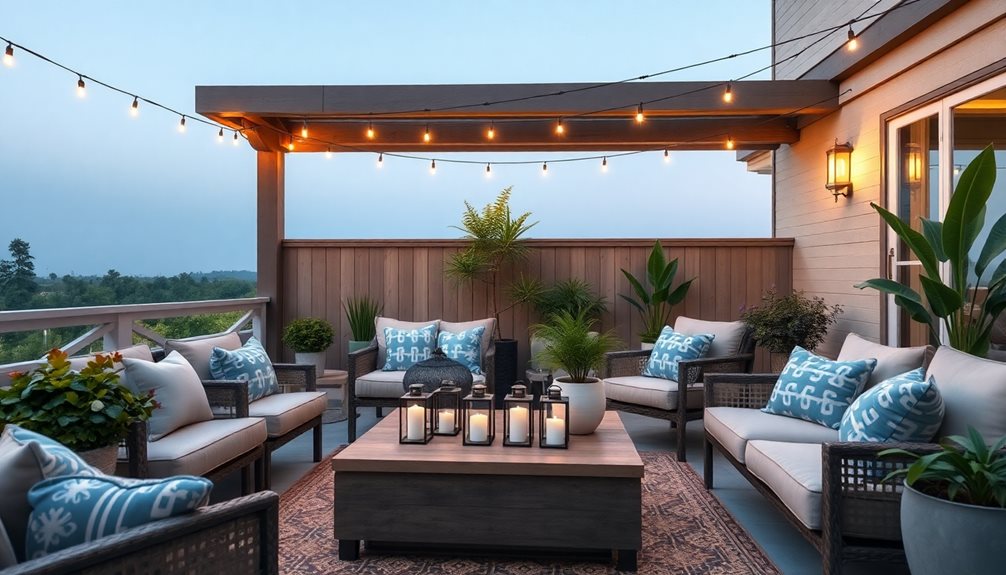
To establish inviting comfort zones within an outdoor living space, careful selection and strategic placement of furniture and decorative elements serve as the foundation for creating distinct functional areas.
Weather-resistant seating arrangements, including deep-cushioned sofas and swivel chairs, should be positioned to facilitate conversation while maximizing views of the surrounding landscape.
Layered lighting elements, such as overhead pendants, landscape spotlights, and tabletop lanterns, create ambiance while extending usability into evening hours.
Decorative all-weather throw pillows, outdoor rugs, and potted plants add warmth and texture, effectively defining separate zones while maintaining visual cohesion throughout the space.
Consider installing durable concrete sidewalks to create elegant pathways between your outdoor living zones, as they can last up to 30 years with proper maintenance.
Lighting and Ambiance for Day-to-Night Entertainment

Strategic lighting design transforms outdoor living spaces from daytime retreats into enchanting nighttime entertainment venues, requiring careful consideration of both natural and artificial illumination sources.
Layered lighting techniques incorporate three essential elements: ambient lighting for overall illumination, task lighting for functional areas, and accent lighting to highlight architectural features.
Well-positioned LED path lights, mounted at 14-16 inches height, guarantee safe navigation while creating visual interest.
Professional designers recommend combining multiple lighting types: low-voltage landscape lights (4-15 watts), weather-resistant pendant fixtures (25-60 watts), and adjustable spotlights (20-50 watts).
Strategic placement of fixtures at varying heights creates depth while minimizing harsh shadows and glare.
Stamped concrete surfaces provide an elegant foundation for outdoor lighting designs while offering durability that lasts over 25 years.
Weather-Smart Solutions for Year-Round Enjoyment
Maximizing outdoor living spaces throughout the changing seasons requires extensive weather protection solutions that address temperature extremes, precipitation patterns, and environmental challenges.
Retractable awnings and pergolas with adjustable louvers provide essential shade control while allowing ventilation. High-performance outdoor heaters, rated at 40,000 BTUs, extend evening gatherings into cooler months.
Flexible shade structures paired with powerful heating solutions create comfortable outdoor spaces that can be enjoyed regardless of weather conditions.
For moisture management, integrated drainage systems and permeable surfaces prevent water accumulation. Wind barriers, including tempered glass panels and strategic landscaping, create protective microclimates.
Durable materials like powder-coated aluminum and marine-grade fabric withstand UV exposure, salt air, and temperature fluctuations while maintaining aesthetic appeal. Professional installation of concrete driveways provides a lasting foundation that can endure up to 30 years of heavy use while complementing your outdoor design.
Expert Final Thoughts
A thoughtfully designed outdoor living space transforms an ordinary backyard into a sophisticated extension of the home, seamlessly blending functionality with style. Through careful consideration of layout, comfort features, lighting design, and weather-resistant elements, homeowners can create an inviting retreat that serves their needs year-round. By implementing these essential design principles and practical solutions, any outdoor area can become a versatile environment for relaxation, entertainment, and everyday living.
Concrete Patio Material Choices Stamped, Stained, Exposed Aggregate
Modern concrete patios offer three primary decorative finishes: stamped patterns that replicate natural stone or brick through textured molds, acid staining that creates variegated earth-tone colors through chemical reactions, and exposed aggregate that reveals decorative stones embedded within the surface. Each option carries distinct maintenance requirements and costs, with stamped concrete ranging $15-20 per square foot, staining at $8-12, and exposed aggregate at $10-15. Understanding the unique characteristics of each finish enables best selection based on aesthetic preferences and regional climate conditions.
Expert Highlights
- Stamped concrete replicates natural materials like stone and brick, requiring coordinated mixing and timing for successful pattern application.
- Acid staining creates unique earth-toned colors through chemical reactions, offering diverse color intensities for sophisticated finishes.
- Exposed aggregate reveals decorative stones like river rock or granite chips through pressure washing and chemical retarders.
- Standard gray concrete costs $6-8 per square foot, while decorative finishes can reach $15-30 per square foot.
- All decorative concrete options require specific maintenance schedules, including annual sealing, pressure washing, and regular cleaning.
Understanding Basic Concrete Patio Options
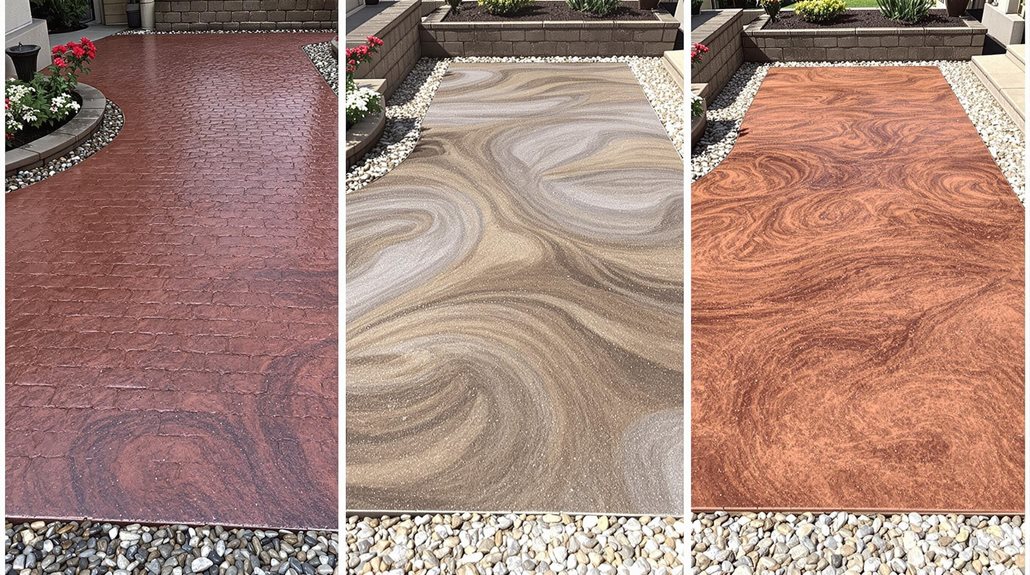
Homeowners exploring concrete patio options must first understand the fundamental choices available regarding basic materials, finishes, and construction methods.
Traditional concrete patios utilize Portland cement mixed with aggregates and water, creating a durable surface that can last decades when properly installed and maintained.
Traditional concrete patios blend Portland cement, aggregates, and water to create long-lasting outdoor surfaces that endure through proper installation and maintenance.
The basic installation process involves preparing a stable subgrade, installing proper drainage and reinforcement, then pouring and finishing the concrete mixture.
While standard gray concrete remains popular due to its affordability and versatility, modern techniques allow for enhanced aesthetic appeal through various finishing methods.
Concrete thickness typically ranges from 4 to 6 inches for residential patios, with thicker slabs required for areas supporting heavy loads or experiencing freeze-thaw cycles.
The concrete mix design must achieve a minimum compressive strength of 3,500 PSI for peak durability and crack resistance.
Working with licensed contractors ensures reliable installation and proper construction techniques from start to finish.
The Art and Appeal of Stamped Concrete

Stamped concrete transforms ordinary concrete patios into artistic surfaces that can replicate the look of natural stone, brick, slate, or even wood grain through specialized patterns and texturing techniques.
The installation process combines colored concrete placement, carefully-timed surface pressing with specialized rubber mats or forms, and skilled finishing work to create three-dimensional impressions that mimic high-end materials.
Professional contractors must coordinate multiple steps precisely, including proper concrete mixing ratios, color hardener application, release agent usage, and stamping timing to achieve ideal pattern depth and authentic-looking textures.
With proper maintenance practices, stamped concrete surfaces can maintain their beauty and structural integrity for over 25 years.
Stamped Pattern Design Options
When exploring the artistic possibilities of concrete patios, stamped patterns emerge as one of the most versatile and aesthetically pleasing design options available to modern construction. The selection of patterns ranges from natural stone textures, including slate, flagstone, and cobblestone, to geometric designs and repeating motifs that complement various architectural styles.
Professional contractors can implement intricate designs using specialized tools and forms, creating authentic-looking textures that mimic high-end materials at a fraction of the cost. Popular options include ashlar cut stone, which features a classic rectangular pattern, and seamless texture skins that replicate weathered wood or natural rock formations.
The depth and complexity of these patterns can be further enhanced through strategic coloring techniques, including integral pigments, color hardeners, and release agents, which add dimension and realism to the finished surface.
Installation and Finishing Process
The intricate process of concrete patio installation begins with thorough site preparation, including proper grading, compaction of the base material, and installation of forms to contain the wet concrete mixture.
Reinforcement materials, such as steel mesh or fiber additives, are positioned to prevent cracking and guarantee structural integrity.
Once the concrete is poured and leveled, contractors apply a release agent to prevent the stamping tools from adhering to the surface.
The concrete must reach the ideal consistency before skilled technicians carefully press specialized rubber mats or stamps into the semi-hardened surface to create the desired pattern and texture.
Final finishing steps include cleaning excess release agent, applying concrete sealers for protection, and allowing proper curing time, typically 24-48 hours for foot traffic and 7-10 days for vehicle traffic.
Color Variations Through Acid Staining
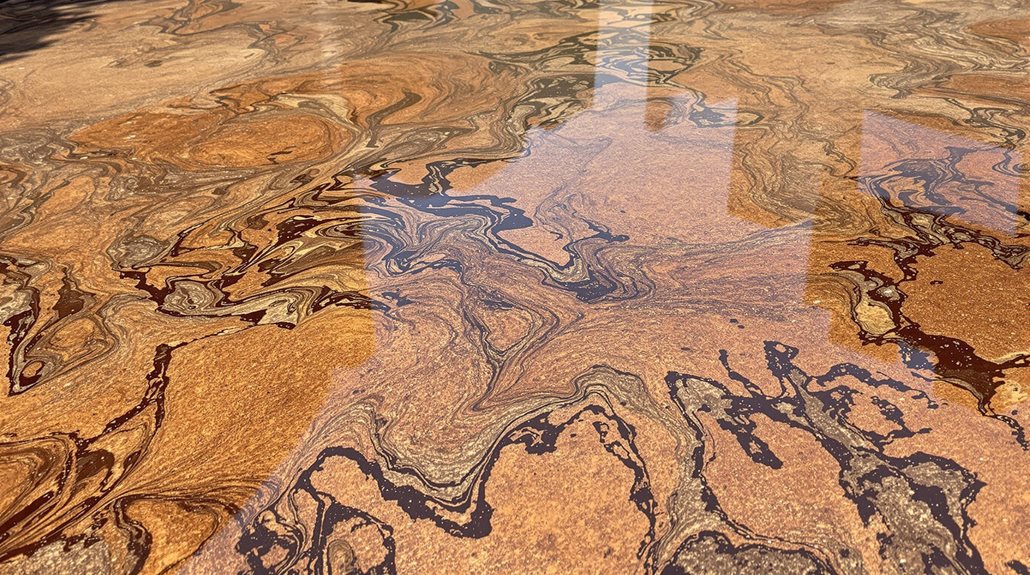
Transforming ordinary concrete into rich, variegated surfaces becomes possible through acid staining, a chemical reaction process that permanently alters the concrete's appearance.
The stains, typically containing metallic salts suspended in an acidic water-based solution, penetrate the concrete surface and react with calcium hydroxide, creating unique earth-toned colors.
Chemical artistry unfolds as metallic salts merge with concrete's calcium hydroxide, transforming gray surfaces into rich, earthen masterpieces.
The resulting patterns emerge in warm browns, terra cottas, and subtle blues or greens, depending on the specific chemical compounds used in the staining process. Multiple applications can create layered effects, while varying the dilution ratios affects color intensity. Environmental factors, such as concrete age and surface conditions, influence the final outcome.
Professional applicators often combine different staining techniques, including spray methods and brush applications, to achieve sophisticated marbling effects that mimic natural stone or leather textures.
With expert craftsmanship from skilled professionals, these decorative finishes can transform both residential and commercial concrete installations into stunning architectural features.
Exposed Aggregate: Natural Beauty Revealed
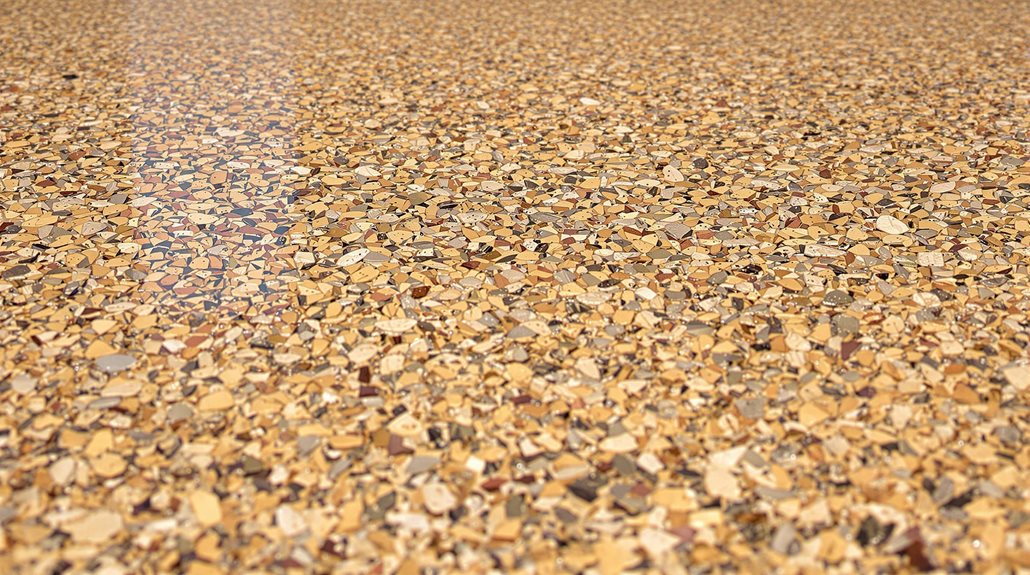
Exposed aggregate installation involves multiple steps, beginning with placing and screeding the concrete mix, followed by washing away the surface mortar to reveal decorative stones beneath.
The process allows contractors to create varied patterns through stone selection and placement techniques, incorporating natural river rock, granite chips, or colored glass in sizes ranging from 1/8 to 3/4 inch.
Designers can achieve striking visual effects by combining different aggregate materials and colors, from earth-toned pebbles that create a naturalistic appearance to vibrant glass chips that produce a modern, architectural statement.
As a certified team member of Legacy General Services, our experts ensure pristine installation and superior quality control throughout the exposed aggregate process.
Installation Steps and Methods
Creating an exposed aggregate patio requires a systematic, multi-step approach that begins well before the concrete is poured.
Initial site preparation involves grading, compacting the soil, and installing proper forms and reinforcement mesh to guarantee structural integrity.
Once the concrete mix is poured to the desired thickness, contractors must wait for the precise moment when the surface begins to set.
At this critical stage, a chemical retarder is applied to delay surface curing while the underlying concrete hardens.
After approximately 24 hours, workers carefully pressure wash the surface to expose the decorative aggregate.
The final steps include allowing the concrete to cure completely for 7-10 days, applying a protective sealer to enhance the aggregate's appearance, and installing control joints to prevent random cracking.
This methodical process guarantees a durable, aesthetically pleasing result.
Patterns and Color Options
Through careful selection of aggregates and matrix colors, exposed aggregate patios offer an extensive range of aesthetic possibilities that blend natural sophistication with practical durability.
Homeowners can choose from river rock, granite chips, or even recycled glass aggregates in various sizes and hues, creating distinctive visual textures that complement surrounding landscapes.
The matrix concrete itself can be tinted using integral color admixtures or surface-applied stains in earth tones, warm grays, or bold terracotta shades.
When combined with different exposure depths and seeding patterns, these options produce unique surface effects ranging from subtle to dramatic.
Professional contractors often create custom aggregate blends, mixing different sizes and colors of stone to achieve specific design objectives while maintaining ideal surface consistency and structural integrity throughout the installation process.
Maintenance Requirements for Different Finishes

While different concrete patio finishes can greatly enhance outdoor spaces, each type requires specific maintenance protocols to preserve its appearance and structural integrity over time.
Selecting the right concrete patio finish demands commitment to proper maintenance practices to ensure lasting beauty and performance.
The level of maintenance needed varies considerably based on the finish type, environmental conditions, and usage patterns.
- Stamped concrete surfaces need annual sealing and occasional pressure washing to prevent staining and maintain color vibrancy.
- Exposed aggregate finishes require periodic cleaning with specialized cleaners to remove organic debris from between stones.
- Stained concrete demands biannual sealing and prompt spill cleanup to protect the coloring agents.
- Polished concrete surfaces benefit from weekly dust mopping and monthly wet cleaning with pH-neutral cleaners.
- Smooth-troweled finishes need regular sweeping and occasional degreasing to prevent slip hazards.
Regular inspection and prompt repairs of any cracks or damage help maintain long-term durability across all finish types.
With proper care and maintenance, concrete surfaces can provide 30 years of service when professionally installed and maintained according to recommendations.
Cost Comparisons Across Patio Styles
The cost variation between basic and premium concrete patio finishes can be substantial, with plain gray concrete starting at $6-8 per square foot while decorative options often exceed $15-20 per square foot.
Premium finishes, such as stamped patterns, exposed aggregate, or stained concrete, typically command higher prices due to increased labor requirements, specialized tools, and more expensive materials.
Installation complexity also impacts overall costs, as intricate designs requiring multiple colors, detailed patterns, or custom scoring can push prices toward $25-30 per square foot or higher in many markets.
With proper maintenance and professional installation by certified concrete experts, these premium concrete finishes can maintain their beauty and durability for up to 30 years.
Average Costs Per Square
Selecting an appropriate concrete patio style requires careful consideration of material costs, which can vary considerably across different options and finishes. Industry averages indicate significant price variations between basic and premium installations, with regional factors affecting final costs.
- Plain concrete patios typically range from $6 to $12 per square foot
- Colored concrete increases costs to $12 to $18 per square foot
- Stamped patterns elevate pricing to $15 to $25 per square foot
- Exposed aggregate installations average $12 to $20 per square foot
- Custom designs with multiple colors and patterns can exceed $30 per square foot
These price points reflect complete installation costs, including base preparation, reinforcement materials, and finishing work.
Labor typically represents 40-60% of total costs, while material expenses vary based on concrete grade, color additives, and surface treatment complexity.
Premium Vs Basic Options
Comparing premium and basic concrete patio installations reveals considerable cost differentials across various style categories, with luxury options often commanding prices 200-300% higher than standard alternatives.
Premium finishes, such as stamped patterns with multiple colors and sealed surfaces, typically range from $15-25 per square foot, while basic broom-finished concrete averages $6-8 per square foot.
High-end treatments incorporate advanced materials like color hardeners, release agents, and protective sealers, which considerably enhance both aesthetics and durability. These premium installations often feature intricate patterns, seamless texturing, and carefully controlled curing processes that require specialized expertise.
Basic installations, while functional and durable, utilize standard gray concrete with simple finishing techniques, making them an economical choice for budget-conscious property owners who prioritize function over decorative elements.
Weather Resistance and Durability Factors
When constructing a concrete patio that will endure for decades, weather resistance and durability factors play crucial roles in material performance and longevity.
Environmental conditions, including freeze-thaw cycles, UV exposure, and precipitation patterns, considerably impact concrete's structural integrity and appearance over time.
Key factors affecting concrete patio durability include:
- Compressive strength rating, typically 3,000 to 4,000 PSI for residential applications
- Air-entrainment percentage, ideally 5-7% for freeze-thaw resistance
- Water-to-cement ratio, ideally 0.45-0.50 for maximum durability
- Surface sealant type and reapplication schedule
- Proper installation of control joints every 8-12 feet
Professional contractors incorporate these durability considerations during both the design and implementation phases, ensuring the finished patio withstands local climate challenges while maintaining its aesthetic appeal through seasonal changes and years of use.
Installation Methods and Timeline
A successful concrete patio installation requires careful planning, precise execution, and adherence to specific timelines throughout multiple phases of construction.
The process typically begins with site preparation, including grading, compaction, and installation of forms and reinforcement, which takes 1-2 days.
Proper site preparation forms the foundation of any successful concrete project, ensuring stability through careful grading, thorough compaction and strategic reinforcement placement.
The concrete pour represents the most critical phase, requiring coordination of delivery trucks and finishing crews to complete the placement within a 2-4 hour window.
After screeding and floating, contractors must wait for the ideal moment to begin finishing operations, including texturing and edging.
The curing phase demands strict attention to temperature and moisture conditions over 7-28 days.
During this period, the concrete should be kept consistently damp and protected from extreme weather conditions, while bearing no significant weight or traffic.
Design Patterns and Border Options
Modern concrete patios offer homeowners an extensive array of design patterns and decorative border options that transform basic slabs into sophisticated outdoor living spaces.
Common design elements incorporate geometric shapes, natural stone patterns, and distinctive border treatments that define spaces and create visual interest.
Professional contractors can implement numerous artistic patterns through:
- Stamped impressions mimicking brick, slate, or cobblestone textures
- Scored patterns creating clean lines and symmetrical sections
- Stenciled designs featuring intricate medallions or custom motifs
- Exposed aggregate borders providing textural contrast
- Saw-cut patterns forming precise geometric shapes
Border treatments often feature contrasting colors or textures that frame the main patio area, incorporating detailed edge work such as bullnose finishing or rolled edges.
These design elements can complement existing architecture while establishing distinct outdoor zones for various activities.
Selecting the Right Finish for Your Climate
Beyond aesthetic design choices, climate conditions considerably influence the selection of concrete patio finishes, as different surface treatments perform differently under varying weather patterns and environmental stresses.
| Climate Type | Recommended Finish | Key Benefits |
|---|---|---|
| Hot/Arid | Smooth Trowel | Reflects heat, minimizes cracking |
| Wet/Humid | Broom Finish | Enhanced traction, water drainage |
| Freeze/Thaw | Salt Finish | Slip resistance, ice management |
For regions experiencing significant temperature fluctuations, penetrating sealers provide superior protection against moisture infiltration and freeze-thaw damage, while maintaining the concrete's ability to breathe. Coastal environments benefit from densifiers and water-repellent treatments that protect against salt exposure and humidity, extending the patio's longevity through enhanced chemical resistance and reduced efflorescence.
Frequently Asked Questions
Can Concrete Patios Be Installed Over Existing Concrete Slabs?
Most homeowners can successfully overlay new concrete onto existing slabs if the base is structurally sound, properly prepared, and has adequate drainage. Professional installation guarantees the best results.
How Long Should I Wait Before Placing Furniture on New Concrete?
Most homeowners should wait at least 24-48 hours before placing light furniture on new concrete, but heavy items require a full 7-10 days for proper curing and maximum strength.
What Causes White Spots or Efflorescence on Concrete Patios?
Efflorescence occurs when water dissolves salt deposits within concrete and carries them to the surface. As moisture evaporates, these salts remain behind, creating white, chalky spots on concrete surfaces.
Can Plants or Tree Roots Damage My Concrete Patio Over Time?
Growing tree roots and aggressive plant systems can gradually crack and lift concrete patios by exerting pressure from below, causing structural damage and uneven surfaces over several years.
Is It Possible to Repair Cracks Without Replacing the Entire Patio?
Small to medium concrete cracks can be repaired using epoxy fillers, patching compounds, or concrete sealants. Many homeowners successfully fix these issues without needing complete patio replacement.
Expert Final Thougts
When choosing a concrete patio finish, homeowners must carefully weigh aesthetic preferences against practical considerations like maintenance needs, climate compatibility, and installation costs. While stamped concrete offers design versatility, acid staining provides rich color variations, and exposed aggregate delivers natural texture, each option presents distinct advantages and challenges. Through thoughtful evaluation of these factors, along with proper installation and maintenance, any of these finishes can provide decades of outdoor enjoyment and value.
Concrete Patio Design Options Modern, Traditional, Rustic
Concrete patio designs offer three distinct style categories: modern, traditional, and rustic. Modern designs feature clean lines, geometric patterns, and minimalist aesthetics with exposed aggregate finishes. Traditional styles incorporate classic stamped patterns like herringbone and running bond brick, while rustic designs utilize specialized stamping techniques that replicate natural materials. Each style can be enhanced through various coloring methods, including integral pigments and acid stains, with proper sealing ensuring longevity. The extensive range of customization options creates limitless possibilities for transforming outdoor spaces.
Expert Highlights
- Modern concrete patios feature clean lines, geometric patterns, and minimalist designs with metallic epoxy coatings and LED lighting systems.
- Traditional designs incorporate stamped patterns like running bond brick and herringbone, with exposed aggregate finishes for durability.
- Rustic concrete patios replicate natural materials through specialized stamping techniques that create wood grain, slate, or river rock textures.
- All design styles can be enhanced with acid stains, water-based stains, or integral pigments for customized color variations.
- Proper sealing every three years maintains appearance and protects decorative finishes across modern, traditional, and rustic designs.
Modern Design Elements for Contemporary Concrete Patios
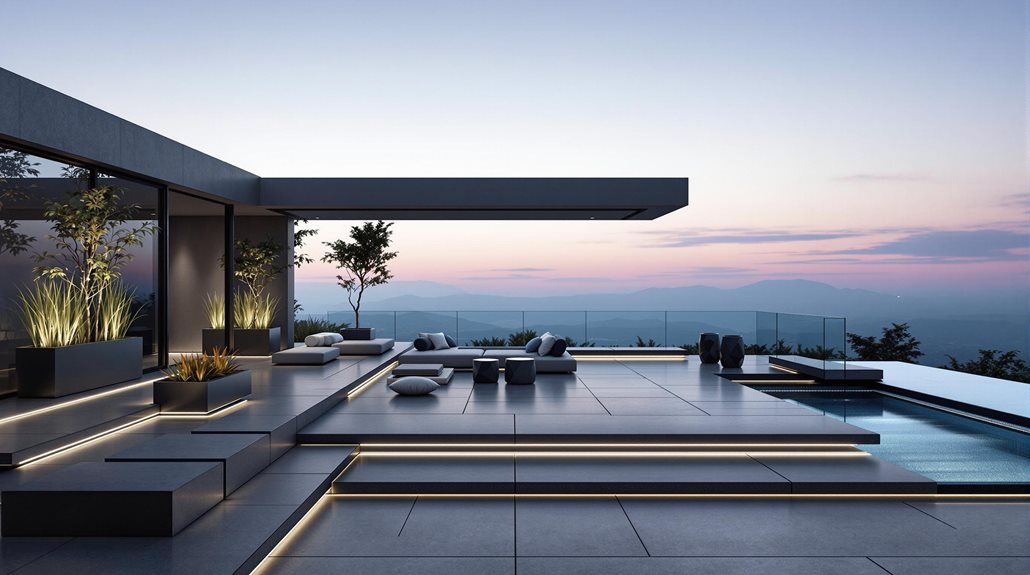
When designing a contemporary concrete patio, modern aesthetic elements have evolved considerably beyond traditional plain gray slabs into sophisticated architectural features that can transform outdoor spaces.
Today's designs incorporate clean lines, geometric patterns, and minimalist elements that reflect current architectural trends.
Modern design elegantly merges simplicity with structure, using clean geometric forms to create sophisticated outdoor spaces that embrace contemporary aesthetics.
Popular modern features include exposed aggregate finishes, metallic epoxy coatings, and integrated LED lighting systems that create dramatic evening ambiance.
Designers frequently utilize large-format scoring patterns, often in 4×4 or 6×6-foot squares, to establish visual rhythm and spatial flow.
Contemporary concrete patios also embrace technological innovations, such as photocatalytic surfaces that actively break down air pollutants, and specialized sealers that provide UV protection while maintaining the concrete's natural appearance.
These advanced materials allow for both aesthetic appeal and practical functionality in modern outdoor living spaces.
Working with skilled contractors ensures proper control joint placement and expert finishing techniques that enhance the overall modern design aesthetic.
Traditional Concrete Patio Patterns and Finishes
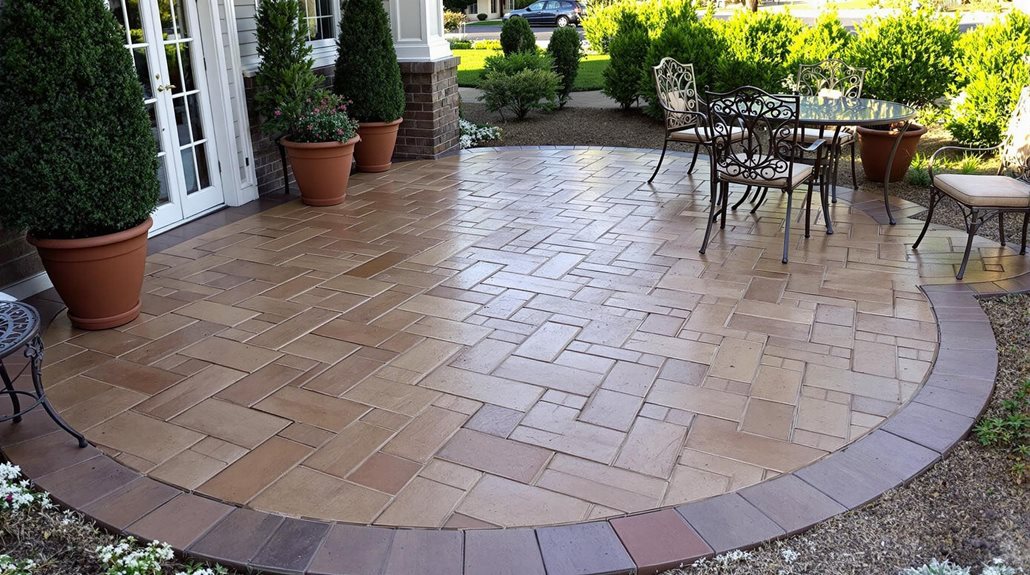
Traditional concrete patio designs offer timeless appeal through well-established patterns and finishing techniques that have withstood decades of architectural evolution. Classic stamped patterns, including running bond brick, herringbone, and ashlar slate, continue to dominate residential installations across North America.
Exposed aggregate finishes, which reveal decorative stones within the concrete matrix, provide durability while maintaining an elegant appearance that complements traditional home architecture.
Scored concrete patterns, typically featuring 4-foot by 4-foot squares with deep control joints, create clean geometric layouts that resist cracking while preserving visual symmetry.
Salt finish texturing, achieved by broadcasting rock salt before the concrete sets, delivers subtle variation in surface texture without compromising the refined appearance expected in traditional design, making it particularly suitable for poolside applications where slip resistance is essential.
With certified expert installation, these traditional finishes can maintain their beauty and functionality for up to 30 years with proper maintenance.
Rustic Charm: Textured and Stamped Concrete Options
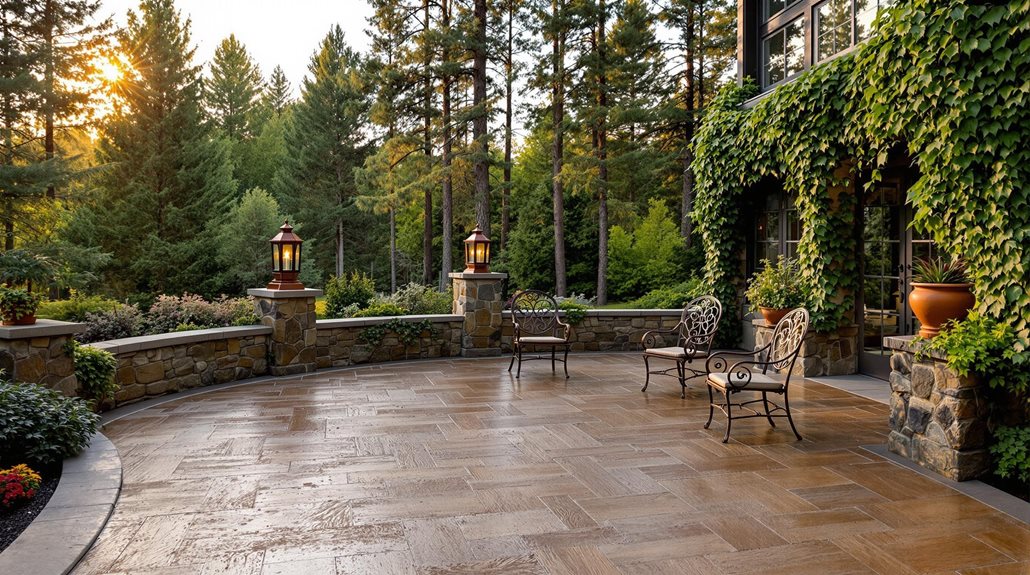
Creating rustic appeal through concrete requires specialized stamping and texturing techniques that faithfully replicate natural materials, such as weathered wood, fractured stone, or hand-chiseled slate.
| Texture Type | Depth Range | Application Method |
|---|---|---|
| Wood Grain | 1/4" – 1/2" | Deep Stamping |
| Slate Pattern | 1/8" – 3/8" | Skin Stamping |
| River Rock | 3/8" – 5/8" | Mat Imprinting |
Professional contractors utilize specialized mats and tools to achieve authentic-looking textures, pressing patterns into semi-cured concrete at precise depths and angles. The process requires careful timing and experienced application to guarantee proper pattern transfer and structural integrity.
These rustic finishes can be enhanced through strategic color integration, using acid stains, powder release agents, and integral pigments that create variegated tones resembling natural aging and weathering processes.
With proper maintenance routines, stamped concrete surfaces can maintain their rustic beauty for over 25 years.
Color Choices and Staining Techniques

Numerous coloring and staining options allow homeowners to transform ordinary concrete patios into rich, personalized outdoor spaces. Concrete colorants include integral pigments mixed directly into wet concrete, surface-applied stains, and dyes that penetrate the material's surface.
Acid stains create variegated, natural-looking effects through chemical reactions with the concrete's minerals, producing earth-toned hues ranging from tans and browns to deep russet and copper patinas. Water-based stains offer a broader color palette, including vibrant blues, greens, and modern grays, while maintaining the concrete's natural variations.
Professional concrete artisans often combine multiple staining techniques, applying layers of color to achieve depth and dimension. Antiquing releases, color hardeners, and specialized sealers further enhance the finished appearance while providing essential protection against weathering and wear. Legacy General Services provides expert staining and coloring services for residential and commercial properties throughout the Twin Cities metropolitan area.
Integrating Borders and Decorative Accents
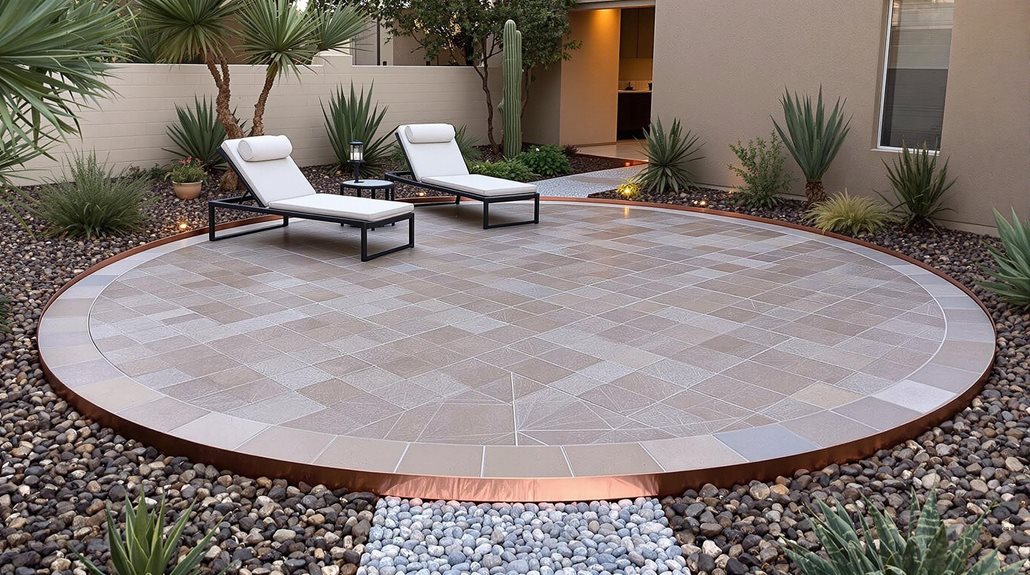
Beyond the foundational color treatments, borders and decorative accents serve as defining architectural elements that frame and enhance concrete patio designs.
Common border treatments include stamped patterns, inlaid tiles, contrasting concrete bands, and decorative aggregate strips that establish visual boundaries while adding sophistication to the overall design.
Sophisticated border elements transform ordinary concrete patios into elegant outdoor spaces through artful combinations of patterns, tiles and decorative bands.
Skilled contractors can integrate numerous decorative elements, including medallions, compass roses, and geometric shapes, which create focal points within the patio space.
These accents, often achieved through techniques such as scoring, stenciling, or embedding materials, can be customized to complement surrounding architecture and landscaping features.
Modern installations frequently incorporate LED lighting strips, metal inlays, or glass aggregate bands along borders, providing both aesthetic appeal and practical functionality for evening entertainment while defining changeover zones between different patio areas.
With proper maintenance and professional sealing every three years, these decorative borders and accents will maintain their visual appeal while protecting against moisture damage.
Seamless Indoor-Outdoor Living Space Solutions
To achieve a harmonious change between interior and exterior spaces, modern concrete patio designs increasingly incorporate architectural elements that blur traditional boundaries between indoors and out.
Flush thresholds, continuous flooring patterns, and matching concrete finishes create visual flow, while large sliding glass doors or folding wall systems eliminate physical barriers.
Strategic design elements, such as covered connections and weather-resistant materials, enable year-round functionality. Concrete surfaces can be color-matched to interior flooring, while integrated drainage systems and proper grading guarantee seamless changes remain practical.
Level surfaces throughout facilitate accessibility and furniture placement.
Lighting design plays an essential role, with recessed fixtures and understated ambient illumination maintaining consistency between spaces.
Temperature control features, including radiant heating and cooling zones, extend comfortable living conditions across the merged environments.
With proper maintenance and care, these durable concrete surfaces can provide up to 30 years of seamless indoor-outdoor living enjoyment.
Frequently Asked Questions
How Long Does a Concrete Patio Typically Last Before Requiring Major Repairs?
A properly installed and maintained concrete patio typically lasts 20-30 years before requiring major repairs. Regular sealing and addressing minor cracks early helps extend its serviceable lifespan.
Can Existing Concrete Patios Be Resurfaced Instead of Completely Replaced?
Most concrete patios can be successfully resurfaced if the base is structurally sound. Resurfacing involves applying a new layer of concrete overlay, offering a cost-effective alternative to complete replacement.
What Maintenance Is Required to Keep a Concrete Patio Looking New?
Regular cleaning, sealing every 2-3 years, prompt stain removal, and crack repair help maintain concrete patios. Homeowners should avoid harsh chemicals and address drainage issues to prevent deterioration.
How Soon Can You Use a Newly Installed Concrete Patio?
After pouring, concrete needs at least 24-48 hours before light foot traffic. For furniture and heavy use, homeowners should wait 7-10 days. Full curing takes about 28 days.
Does Weather Affect Concrete Patio Installation and Curing Time?
Weather considerably impacts concrete patio installation and curing. Temperature, humidity, wind, and precipitation can affect setting times, with ideal conditions being moderate temperatures and no rain.
Expert Final Thougts
Concrete patios offer remarkable versatility through modern, traditional, and rustic design approaches, each providing distinct aesthetic and functional benefits. Through careful selection of patterns, textures, colors, and decorative elements, homeowners can create outdoor spaces that seamlessly extend their living areas while reflecting personal style. Whether employing sleek contemporary lines, classic geometric patterns, or natural-looking finishes, concrete remains an adaptable, durable, and cost-effective foundation for exceptional outdoor living spaces.
